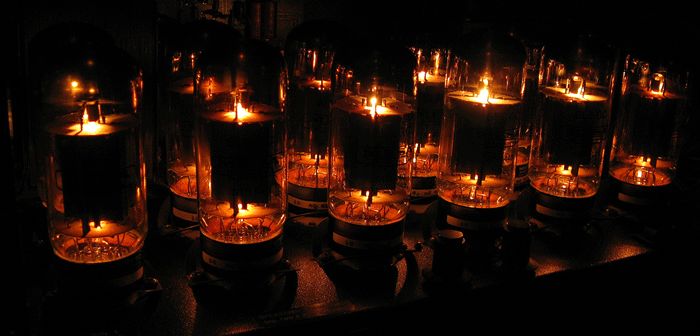What is Plate Current (PC) and why do we show this on some of our valves/tubes?
Author: Ian Bush Date Posted:18 September 2018
Plate current
There are 3 main parts to valves. (1) The Plate, (2) The Grid and (3) The Cathode. (Pentode valves have an additional 2 elements, but that is out of the scope of this article). The Grid is what controls the flow of current through the valve, much like the handle on a kitchen tap controls the flow of water.
The Plate current is a measure of how much current flows through a particular valve at any point in time. That current will vary with the guitar signal and the bias. You might see on our website that certain valves show a "PC" (or Plate Current) value. The is the plate current at idle (“idle” means no guitar sound being amplified) and is one of the methods used to match up valves. (The other common method is Transconductance or Gm).

What type of amps need matched valves?
Generally speaking, single-ended amps (also known as “true” class A amps) like the famous Fender Champ and the Joyo JTA-05 don't need matched valves but anything class A/B does, even the not-quite-Class A amps like the Vox AC30 sounds much better with matched power valves. Think of “matching” like to people pulling on a rope in a tug of war. By matching your tubes, you are trying to maintain the balance between both sides.
In a class A/B amp you have 2 (or 4) valves running each side of the waveform, one valve pushes, while the other valve pulls. Ideally, you want this push and pull to be matched. If it's not matched you will have an asymmetrical waveform and get more distortion (and not the pleasant tube-style distortion that everyone wants). Power tubes which may be perfectly matched will start to drift with time. If you’re lucky, they will drift in the same direction by the same amount. If they drift in opposite directions or at different rates, it will be a good idea to swap out your power valves.
The easiest way to tell if your amp needs a matched pair is to check in your manual or do some searching on the internet. I once spent a few days with Hartley Peavey, the founder of Peavey (link https://en.wikipedia.org/wiki/Hartley_Peavey) and in his opinion valve matching and biasing was a waste and a potential source of expensive errors. Hartley’s theory is that Peavey Valve amps use matched valves and if you replace them with the same matching code, they amp won’t need rebaising. While it is true that a Cathode-biased (also known as “self-biased”) amps like the Vox AC-30 don’t need biasing, it is still important to use a matched set of power tubes.
Do Preamp valves need to be matched?
The most common preamp valve is the trusty 12AX7. When these valves are used in the preamp section it's not generally needed to be matched. Inside the glass tube of a 12AX7 there are 2 independent gain circuits. These do the very important task of amplifying your guitar signal up from tiny levels which are susceptible to noise, and increases the signal to many volts. From here your guitar signal goes to your tone circuits, reverb, and finally is split into the 2 different phases needed by your matched and biased power tubes.
To get your Amp repaired, or the matching of your power tubes checked, just ask Chris Tarakson, The Guitar Amp Tech. You can visit his website here. Chris does all our amp repairs here at Artist Guitars so you're welcome to leave your amps at our store in Yennora for Chris to pick-up and drop off too.
Reference Links
https://www.apexmatching.com/why-should-i-match-my-tubes
https://www.duncanamps.com/technical/valvematch.html
Thanks for reading our report, to give you even more content check our pages below:
- Join our newsletter for tips, advice, new products and great deals
- Visit our YouTube channel for some great Demo’s & Tutorials
- Our facebook page for updates and specials and more
- Visit our website
I hope this article has helped, if you need any assistance please email:
© Artist Guitars 2018
